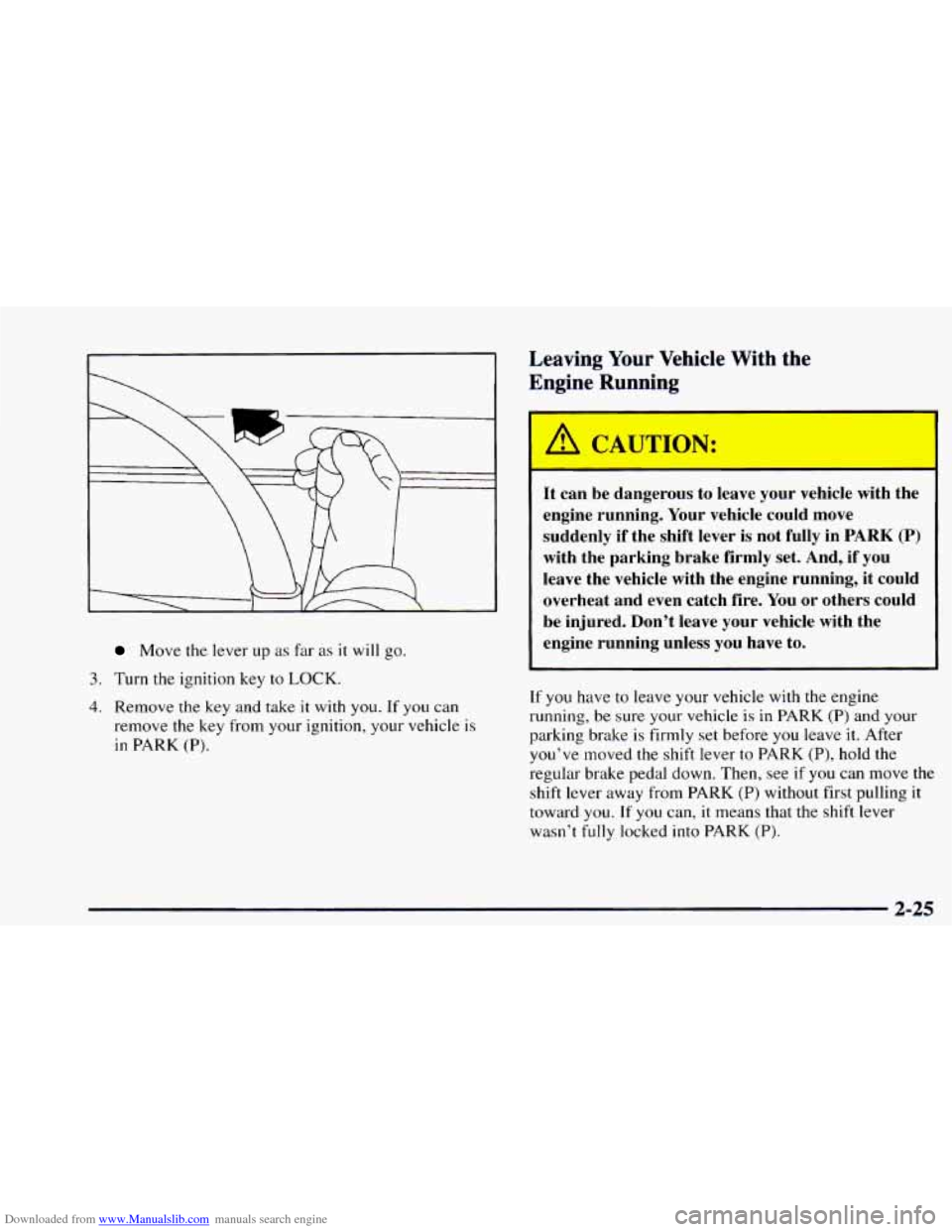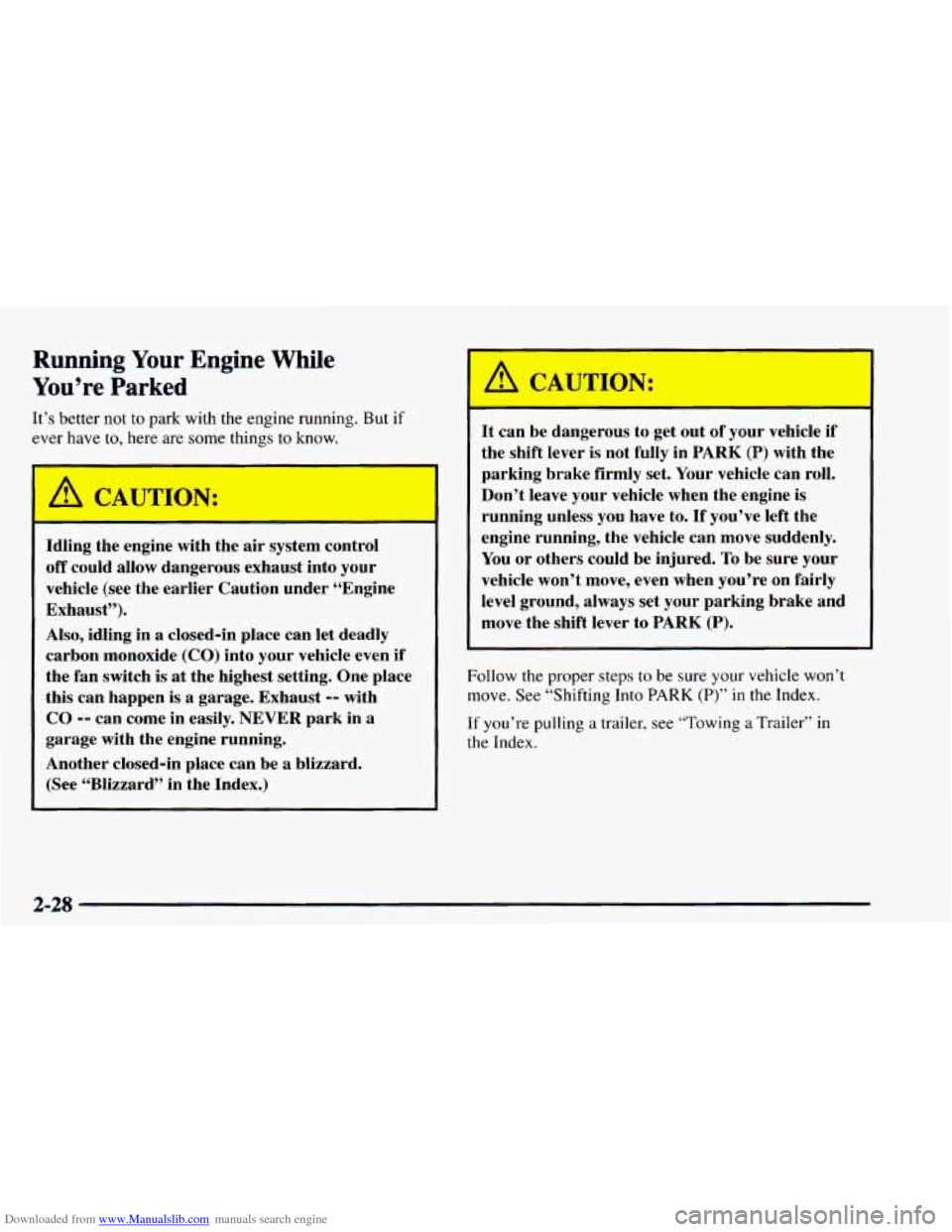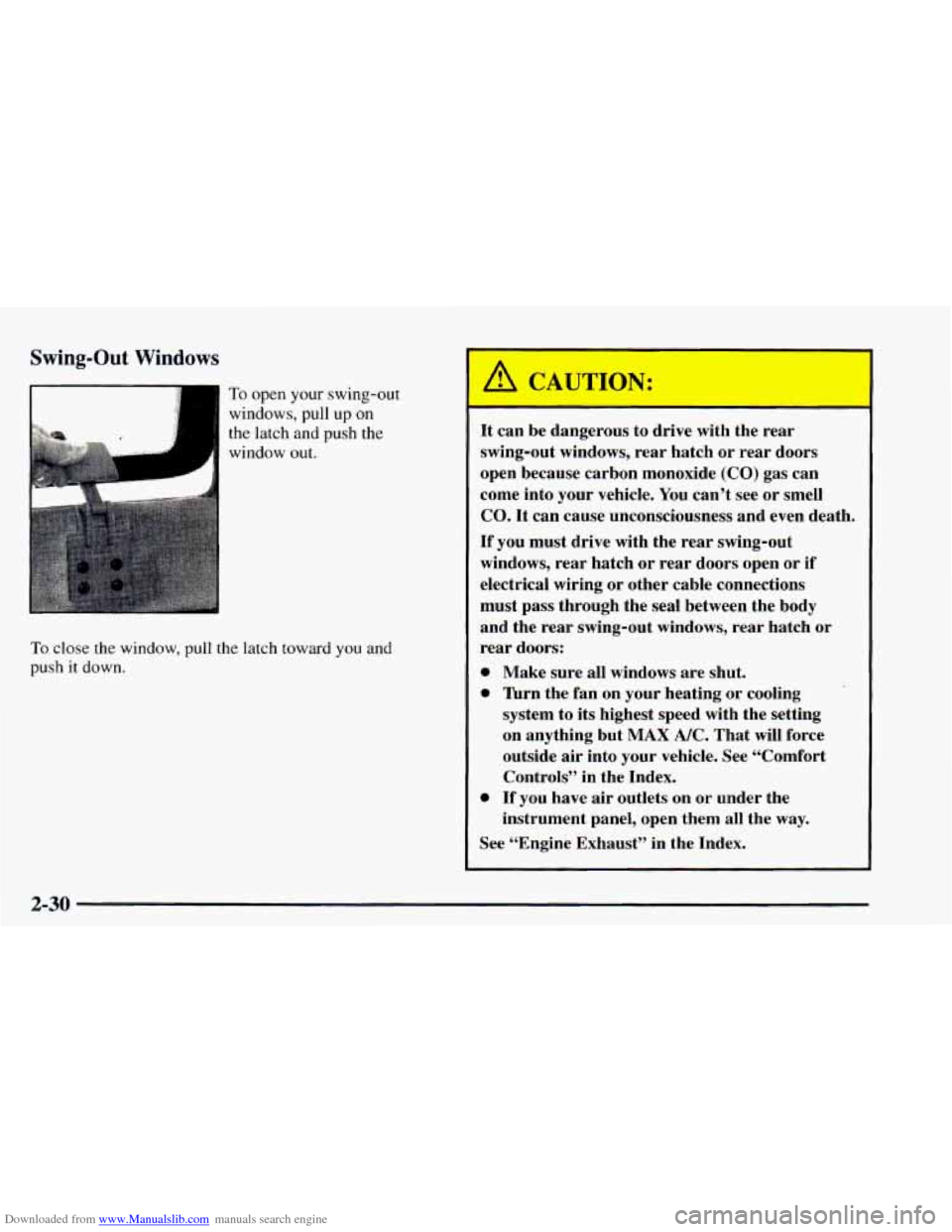Page 97 of 404
Downloaded from www.Manualslib.com manuals search engine Parking Brake
To set the parking brake, hold the regular brake pedal
down with your right foot.
Push down the parking brake pedal with your left foot.
If the ignition is
on, the brake system warning light will
come
on.
To release the parking brake, hold the regular brake
pedal down. Pull the brake release lever located on the
lower
left side of the steering column.
I NOTICE:
Driving with the parking brake on can cause
your rear brakes to overheat. You may have to
replace them, and you could also damage other
parts
of your vehicle.
If you are towing a trailer and are parking on any hill,
see “Towing a Trailer’’ in the Index. That section shows
what
to do first to keep the trailer from moving.
2-23
Page 98 of 404
Downloaded from www.Manualslib.com manuals search engine Shiftir: Into PARK (P)
A CAUTION:
It can be dangerous to get out of your vehicle if
the shift lever is not fully in PARK (P) with the
parking brake firmly set. Your vehicle can roll.
If you have left the engine running, the vehicle
can move suddenly. You or others could be
injured.
To be sure your vehicle won’t move, even
when you’re on fairly level ground, use the steps
that follow. If you’re pulling a trailer, see
“Towing
a Trailer” in the Index.
1. Hold the brake pedal down with your right foot and
set the parking brake.
2. Move the shift lever into the PARK (P) position
like this:
1
Pull the lever toward you.
2-24
Page 99 of 404

Downloaded from www.Manualslib.com manuals search engine Move the lever up as far as it will go.
3. Turn the ignition key to LOCK.
4. Remove the key and take it with you. If you can
remove the key from your ignition, your vehicle is
in PARK
(P).
Leaving Your Vehicle With the
Engine Running
It can be dangerous to leave your vehicle with the
engine running. Your vehicle could move
suddenly if the shift lever is not fully in
PARK (P)
with the parking brake firmly set. And, if you
leave the vehicle with the engine running, it could
overheat and even catch fire. You
or others could
be injured. Don’t leave your vehicle with the
engine running unless you have to.
If you have to leave your vehicle with the engine
running, be sure your vehicle
is in PARK (P) and your
parking brake
is firmly set before you leave it. After
you’ve moved the shift lever to PARK (P), hold the
regular brake pedal down. Then, see if
you can move the
shift lever away from
PARK (P) without first pulling it
toward you. If you can, it means that the shift lever
wasn’t
fully locked into PARK (P).
2-25
Page 102 of 404

Downloaded from www.Manualslib.com manuals search engine Running Your Engine While
You’re
Parked
It’s better not to park with the engine running. But if
ever have to, here are some things to know.
Idling the engine with the air system control
off could allow dangerous exhaust into your
vehicle (see the earlier Caution under “Engine
Exhaust”).
Also, idling in
a closed-in place can let deadly
carbon monoxide (CO) into your vehicle even if
the fan switch is at the highest setting. One place this can happen is
a garage. Exhaust -- with
CO -- can come in easily. NEVER park in a
garage with the engine running.
Another closed-in place can be
a blizzard.
(See “Blizzard” in the Index.) It can
be dangerous
to get out of your vehicle if
the shift lever is not fully in
PARK (P) with the
parking brake firmly set. Your vehicle can roll.
Don’t leave your vehicle when the engine is
running unless you have to. If you%e left the
engine running, the vehicle can move suddenly.
You or others could be injured. To be sure your
vehicle won’t move, even when you’re on fairly
level ground, always set your parking brake and
move the shift lever to
PARK (P).
Follow the proper steps to be sure your vehicle won’t
move. See “Shifting Into
PARK (P)” in the Index.
If you’re pulling a trailer, see “Towing a Trailer” in
the Index.
2-28
Page 104 of 404

Downloaded from www.Manualslib.com manuals search engine Swing-Out Windows
To open your swing-out
windows, pull up on
the latch and push the
window out.
To close the window, pull the latch toward you and
push it down. It can be dangerous to drive with the rear
swing-out
windows, rear hatch or rear doors
open because carbon monoxide (CO) gas can
come into your vehicle. You can’t see or smell
CO. It can cause unconsciousness and even death,
If you must drive with the rear swing-out
windows, rear hatch or rear doors open or if
electrical wiring
or other cable connections
must pass through the seal between the body and the rear swing-out windows, rear hatch
or
rear doors:
0
e
0
Make sure all windows are shut.
Turn the fan on your heating or cooling
system to its highest speed with the setting
on anything but MAX A/C. That will force
outside air into your vehicle. See “Comfort
Controls” in the Index.
If you have air outlets on or under the
instrument panel, open them
all the way.
See “Engine Exhaust” in the Index.
2-30
Page 106 of 404

Downloaded from www.Manualslib.com manuals search engine mrn and Lane Change Signals
The turn signal has two upward (for right) and two
downward (for left) positions. These positions allow
you to signal a turn or a lane change.
To signal a turn, move the lever all the way up or
down. When the turn is finished, the lever will
return automatically.
An arrow on the instrument
panel will flash
in the
direction of the turn or
lane change.
To signal a lane change, just raise or lower the lever
until the arrow starts to flash. Hold it there until you
complete your lane change. The lever will return by
itself when
you release it.
As you signal a turn or a lane change, if the arrows
don’t flash but just stay on, a signal bulb may be
burned
out and other drivers won’t see your turn signal. If
a bulb is burned out, replace it to help avoid an
accident.
If the arrows don’t go on at all when you
signal a turn, check the fuse (see “Fuses and Circuit
Breakers”
in the Index) and for burned-out bulbs.
If
you have a trailer towing option with added wiring
for the trailer lamps, a different turn signal flasher is
used. With this flasher installed, the signal indicator
will flash even if a turn signal bulb is burned out. Check
the front and rear turn signal lamps regularly to make
sure
they are working.
Headlamp High/Low Beam Changer
To change the headlamps from low beam to high or high
to low, pull the multifunction lever all the way toward
you. Then release
it.
When the high beams are
on, this indicator light on
the instrument panel also
will be on.
2-32
Page 112 of 404

Downloaded from www.Manualslib.com manuals search engine Rotate the knob clockwise again to the master
lighting symbol
to turn on all the lamps listed as
well as the headlamps.
Rotate the knob counterclockwise
to OFF to turn off
your lamps.
Rotate the dial next to the knob up
to adjust your
instrument panel lights. Rotate the dial up
to the first
notch for full intensity.
If you rotate the dial to the
second notch, your interior lamps will come on.
Rotate the dial next to the lamp switch down
to dim
your instrument panel lights.
Headlamps
You can switch your headlamps from high to low beam
by pulling the multifunction lever toward
you.
A circuit breaker protects your headlamps. If you have
an electrical overload, your headlamps will flicker on
and off. Have your headlamp wiring checked right away
if this happens.
Headlamps On Reminder
A reminder tone will sound when your headlamps or
parking lamps are turned on and your ignition is
in the
OFF, LOCK or ACCESSORY position. To turn the tone
off, turn the switch to
OFF.
Daytime Running Lamps
Daytime Running Lamps (DRL) can make it easier
for others
to see the front of your vehicle during the
day. DRL can be helpful in many different driving
conditions, but they can be especially helpful
in the
short periods after dawn and before sunset.
The DRL system will make your headlamps come
on at
a reduced brightness when:
0 the ignition is on,
0 the headlamp switch is off and
0 the parking brake is released.
2-38
Page 115 of 404
Downloaded from www.Manualslib.com manuals search engine Mirrors
Inside Daymight Rearview Mirror Outside
Mirrors
Adjust your
outside mirrors so you can just see the side
of your vehicle.
Some mirrors are manually adjustable. The optional
electric mirrors come
with a remote control adjustment
switch, Find the switch on the driver’s door.
You can adjust the mirror for day or night driving. Press
the tab forward (away from
you) for day driving. Pull
the tab back (toward
you) for night driving.
To move
a mirror, turn the knob in the middle of the
control to
L for the driver’s side mirror or to R for
the passenger’s side mirror. Then press the four-way
pad
to move the mirror in the desired direction.
2-41